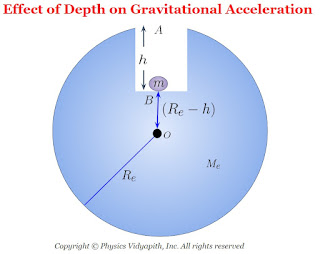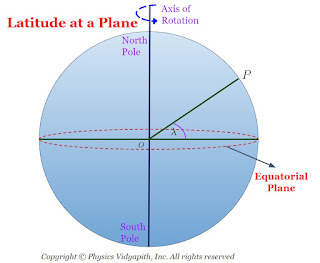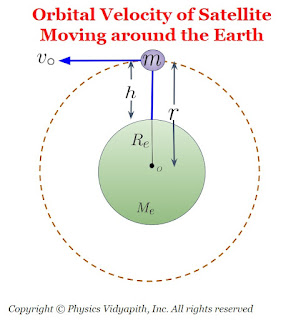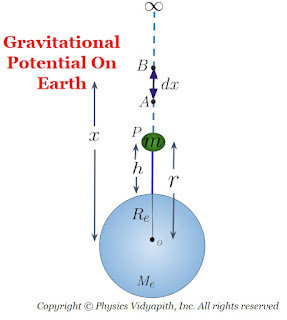Definition of Escape Velocity:
Deduction Escape Velocity Expression:
Let us consider the following:
The mass of the planet =$M$
The radius of the planet = $R$
The mass of the object = $m$ The gravitational force on an object at position $P$ which is a distance $x$ from the surface of the planet
$F=G\frac{M m}{x^{2}} \qquad(1)$
The work done by the force to move the object a very small distance $dx$ from position $A$ to $B$
$W=F.dx$
$dw=G\frac{M m}{x^{2}}dx$
The total work done to move the object from the surface of the planet to infinity
$\int^{W}_{0}dw= \int^{\infty}_{R}G\frac{M m}{x^{2}}dx$
$\left[ w \right]^{W}_{0}=G M m \int^{\infty}_{R} \frac{dx}{x^{2}}$
On solving the above equation
$W=GM m \int^{\infty}_{R} \frac{dx}{x^{2}}$
$W=GM m \left[ -\frac{1}{x} \right]^{\infty}_{R}$
$W=GM m \left[ -\frac{1}{\infty} + \frac{1}{R} \right]$
$W=GM m \left[\frac{1}{R} \right]$
$W=\frac{G M m}{R}$
The above work done is given to the object in the form of kinetic energy to projectile from the surface of the planet to infinity. i.e.
$\frac{1}{2} m v^{2}_{e}= \frac{G M m}{R} $
Where $v_{e}$ is the escape velocity of the object.
$v^{2}_{e} = \frac{2G M m}{R}$
$v_{e} = \sqrt{\frac{2G M}{R}} \qquad(2)$
$v_{e} = \sqrt{\frac{2gR^{2}}{R}} \qquad \left(\because GM=gR^{2} \right)$
$v_{e} = \sqrt{2gR} \qquad(3)$
For earth put mass of the planet $M=M_{e}$ and $R=R_{e}$ in the above equation$(2)$ and equation$(3)$ and we get
$v_{e} = \sqrt{\frac{2G M_{e}}{R_{e}}} $
$v_{e} = \sqrt{2gR_{e}} $
Now substitute the value of the $g=9.8 m/s^{2}$ and radius of earth $R_{e}= 6.4 \times 10^{6} m$ then the escape velocity of the object
$v_{e}=11.2 m/s$
This is the escape velocity of the earth.
Now put $M=\frac{4}{3} \pi R^{3}$ in the above equation $(2)$ then we get
$v_{e} = \sqrt{\frac{2G \frac{4}{3} \pi R^{3}}{R}} $
$v_{e} = \sqrt{\frac{8 \pi \rho G R^{2}}{3}} \qquad(4)$
From the equation $(2)$, $(3)$, and $(4)$ we can conclude that
1.) The escape velocity of the object does not depend on the mass of the object.
2.) The escape velocity of the object is depend upon the mass and radius of the planet.
3.) If the velocity of the object is less than the escape velocity, then the object will reach a certain height and may either move in an orbit around the earth or may fall back to the planet.
4.) If the velocity of projection $(v)$ of the body from the surface of a planet is greater than the escape velocity $v_{e}$ of the planet, the body will escape out from the gravitational field of that planet and will move the interstellar space with velocity $v'$ which can be obtained by using the conservation of energy.
$\frac{1}{2}mv^{2}+\left( -\frac{GMm}{R} \right)= \frac{1}{2}mv'^{2}+0$
$\frac{1}{2}mv^{2}+\left( -\frac{GMm}{R} \right)= \frac{1}{2}mv'^{2}$
$v'^{2}= v^{2} - \frac{2GM}{R}$
$v'^{2}= v^{2} - v^{2}_{e} \qquad \left( \because v^{2}_{e} = \frac{2GM}{R} \right)$
$v'= \sqrt{v^{2} - v^{2}_{e}}$
The relation between orbital velocity and escape velocity of an object:
We know that the orbital velocity of any object revolving near the planet is
$v_{\circ} = \sqrt{gR} \qquad(1)$
The escape velocity of an object which is placed on the planet is
$v_{e} = \sqrt{2gR} \qquad(2)$
From the above equation $(1)$ and equation $(2)$, we get
$v_{e} = \sqrt{2} v_{\circ}$
Alternative Method to Derive Expression for Escape Velocity:
The potential energy of an object on the surface of the planet
$U=-\frac{GMm}{R}$
If the object is thrown vertically in the upward direction with escape velocity $v_{e}$, then the kinetic energy of the object:
$K=\frac{1}{2}mv_{e}^{2}$
We know that the total energy of the object is zero at infinity and then
$K+U=0$
Now substitute the value of $K$ and $U$ in the above equation
$\left( \frac{1}{2}mv_{e}^{2} \right)+\left( -\frac{GMm}{R} \right)=0$
$ \frac{1}{2}mv_{e}^{2} -\frac{GMm}{R} =0$
$ \frac{1}{2}mv_{e}^{2} = \frac{GMm}{R} $
$ \frac{1}{2}v_{e}^{2} = \frac{GM}{R} $
$v_{e}^{2} = \frac{2GM}{R} $
$v_{e} = \sqrt {\frac{2GM}{R}} $
$v_{e} = \sqrt{\frac{2gR^{2}}{R}} \qquad \left(\because GM=gR^{2} \right)$
$v_{e} = \sqrt{2gR} $
The minimum velocity, by which an object is thrown vertically in an upward direction and that object goes out from the gravitation field of the planet and does not come back, is called the escape velocity.
The radius of the planet = $R$
The mass of the object = $m$ The gravitational force on an object at position $P$ which is a distance $x$ from the surface of the planet



















